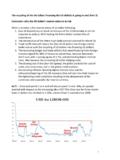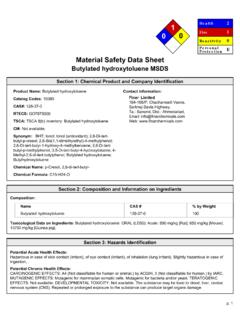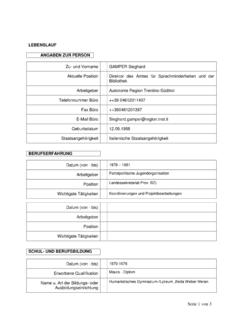Transcription of Basel Committee on Banking Supervision
1 Basel Committee on Banking Supervision Guidance on credit risk and accounting for expected credit losses December 2015 This publication is available on the BIS website ( ). Bank for International Settlements 2015. All rights reserved. Brief excerpts may be reproduced or translated provided the source is stated. ISBN 978-92-9197-386-6 (print) ISBN 978-92-9197-387-3 (online) Guidance on credit risk and accounting for expected credit losses iii Contents Principles underlying this document .. 1 Introduction .. 2 Supervisory guidance for credit risk and accounting for expected credit losses .. 6 Supervisory evaluation of credit risk practices, accounting for expected credit losses and capital adequacy .. 20 Appendix: Supervisory guidance specific to banks applying IFRS .. 23 Guidance on credit risk and accounting for expected credit losses 1 Guidance on credit risk and accounting for expected credit losses Principles underlying this document This supervisory guidance is structured around 11 principles.
2 Supervisory guidance for credit risk and accounting for expected credit losses Principle 1: A bank s board of directors (or equivalent) and senior management are responsible for ensuring that the bank has appropriate credit risk practices, including an effective system of internal control, to consistently determine adequate allowances in accordance with the bank s stated policies and procedures, the applicable accounting framework and relevant supervisory guidance. Principle 2: A bank should adopt, document and adhere to sound methodologies that address policies, procedures and controls for assessing and measuring credit risk on all lending exposures. The measurement of allowances should build upon those robust methodologies and result in the appropriate and timely recognition of expected credit losses in accordance with the applicable accounting framework. Principle 3: A bank should have a credit risk rating process in place to appropriately group lending exposures on the basis of shared credit risk characteristics.
3 Principle 4: A bank s aggregate amount of allowances, regardless of whether allowance components are determined on a collective or an individual basis, should be adequate and consistent with the objectives of the applicable accounting framework. Principle 5: A bank should have policies and procedures in place to appropriately validate models used to assess and measure expected credit losses. Principle 6: A bank s use of experienced credit judgment, especially in the robust consideration of reasonable and supportable forward-looking information, including macroeconomic factors, is essential to the assessment and measurement of expected credit losses. Principle 7: A bank should have a sound credit risk assessment and measurement process that provides it with a strong basis for common systems, tools and data to assess credit risk and to account for expected credit losses. Principle 8: A bank s public disclosures should promote transparency and comparability by providing timely, relevant and decision-useful information.
4 Supervisory evaluation of credit risk practices, accounting for expected credit losses and capital adequacy Principle 9: Banking supervisors should periodically evaluate the effectiveness of a bank s credit risk practices. Principle 10: Banking supervisors should be satisfied that the methods employed by a bank to determine accounting allowances lead to an appropriate measurement of expected credit losses in accordance with the applicable accounting framework. Principle 11: Banking supervisors should consider a bank s credit risk practices when assessing a bank s capital adequacy. 2 Guidance on credit risk and accounting for expected credit losses This paper is intended to set out supervisory guidance on accounting for expected credit losses that does not contradict applicable accounting standards established by standard Representatives of the International Accounting Standards Board (IASB) have been provided with the opportunity to comment on this document and have not identified any aspects of it that would prevent a bank from meeting the impairment requirements of International Financial Reporting Standard (IFRS) 9 Financial Instruments.
5 Introduction Objective 1. The objective of this paper is to set out supervisory guidance on sound credit risk practices associated with the implementation and ongoing application of expected credit loss (ECL) accounting frameworks. The scope of credit risk practices for this guidance is limited to those practices affecting the assessment and measurement of expected credit losses and allowances under the applicable accounting framework. As used in this paper, the term allowances includes allowances on loans, and allowances or provisions on loan commitments and financial guarantee 2. In June 2006, the Basel Committee on Banking Supervision ( the Committee ) issued supervisory guidance on Sound credit risk assessment and valuation for loans to address how common data and processes may be used for credit risk assessment, accounting and capital adequacy purposes and to highlight provisioning concepts that are consistent in prudential and accounting This document replaces the Committee s June 2006 guidance.
6 3. This paper provides banks with supervisory guidance on how the ECL accounting model should interact with a bank s overall credit risk practices and regulatory framework, but does not endeavour to set out regulatory capital requirements on expected loss provisioning under the Basel capital 4. The Committee has issued separate papers on a number of related topics in the area of credit risk, including credit risk modelling and credit risk management. Banking supervisors have a natural interest in promoting the use of sound and prudent credit risk practices by banks. Experience indicates that a significant cause of bank failures is poor credit quality and deficient credit risk assessment and measurement practices. Failure to identify and recognise increases in credit risk in a timely manner can aggravate and prolong the problem. Inadequate credit risk policies and procedures may lead to delayed recognition and measurement of increases in credit risk, which affects the capital adequacy of banks and hampers the proper assessment and control of a bank s credit risk exposure.
7 The bank risk management function s involvement in the assessment and measurement of accounting ECL is essential to ensuring adequate allowances in accordance with the applicable accounting framework. 5. Historically, the incurred-loss model served as the basis for accounting recognition and measurement of credit losses and was implemented with significant differences from jurisdiction to jurisdiction, and among banks within the same jurisdiction, due to the development of national, regional 1 As of the date of publication of this guidance, the US Financial Accounting Standards Board (FASB), which establishes the accounting principles generally accepted in the United States, had not issued its final accounting standard on expected credit losses. The FASB issued its proposed standard on expected credit losses in December 2012, and the tentative decisions determined by its board during redeliberations are published on its website.
8 2 See paragraphs 10 11 for further discussion on scope. 3 Available at 4 Available at Guidance on credit risk and accounting for expected credit losses 3 and entity-specific practices. In revising its 2006 guidance on the verge of a global transition to ECL accounting frameworks, the Committee emphasises the importance of high-quality, robust and consistent implementation of applicable ECL accounting frameworks, both within and across all jurisdictions. With regard to consistency, the Committee recognises that differences exist between ECL accounting frameworks across jurisdictions. This guidance does not intend to drive convergence between different accounting frameworks when differences exist between these frameworks for example, by requiring or prohibiting lifetime ECL measurement at initial recognition of a lending exposure. This guidance does aim to drive consistent interpretations and practices where there are commonalities across accounting frameworks and when the same accounting framework is applied.
9 6. The move to ECL accounting frameworks by accounting standard setters is an important step forward in resolving the weakness identified during the financial crisis that credit loss recognition was too little, too late. The development of ECL accounting frameworks is also consistent with the April 2009 call by the G20 Leaders for accounting standard setters to strengthen accounting recognition of loan loss provisions by incorporating a broader range of credit information .5 7. This paper sets out supervisory guidance for ECL accounting that does not contradict the applicable accounting standards established by accounting standard setters. Rather, the paper presents the Committee s view of the appropriate application of those standards. 8. The guidance in the main section of this paper is equally applicable under all ECL accounting frameworks. For jurisdictions in which ECL accounting frameworks are not required, the Committee expects that the relevant aspects of this guidance related to sound credit risk practices will be applied, as far as appropriate, within the context of the applicable accounting framework.
10 An appendix is included that relates to IFRS 9 as issued by the IASB, which describes supervisory guidance specific to jurisdictions applying the IFRS 9 ECL requirements. 9. Recognising that banks may have well established regulatory capital models for the measurement of expected losses, these models may be used as a starting point for estimating ECL for accounting purposes; however, regulatory capital models may not be directly usable in the measurement of accounting ECL due to differences between the objectives of and inputs used for each of these purposes. For example, the Basel capital framework s expected loss calculation for regulatory capital, as currently stated, differs from accounting ECL in that the Basel capital framework s probability of default may be through the cycle and is based on a 12-month time horizon. Additionally, loss-given-default in the Basel capital framework reflects downturn economic conditions.


















